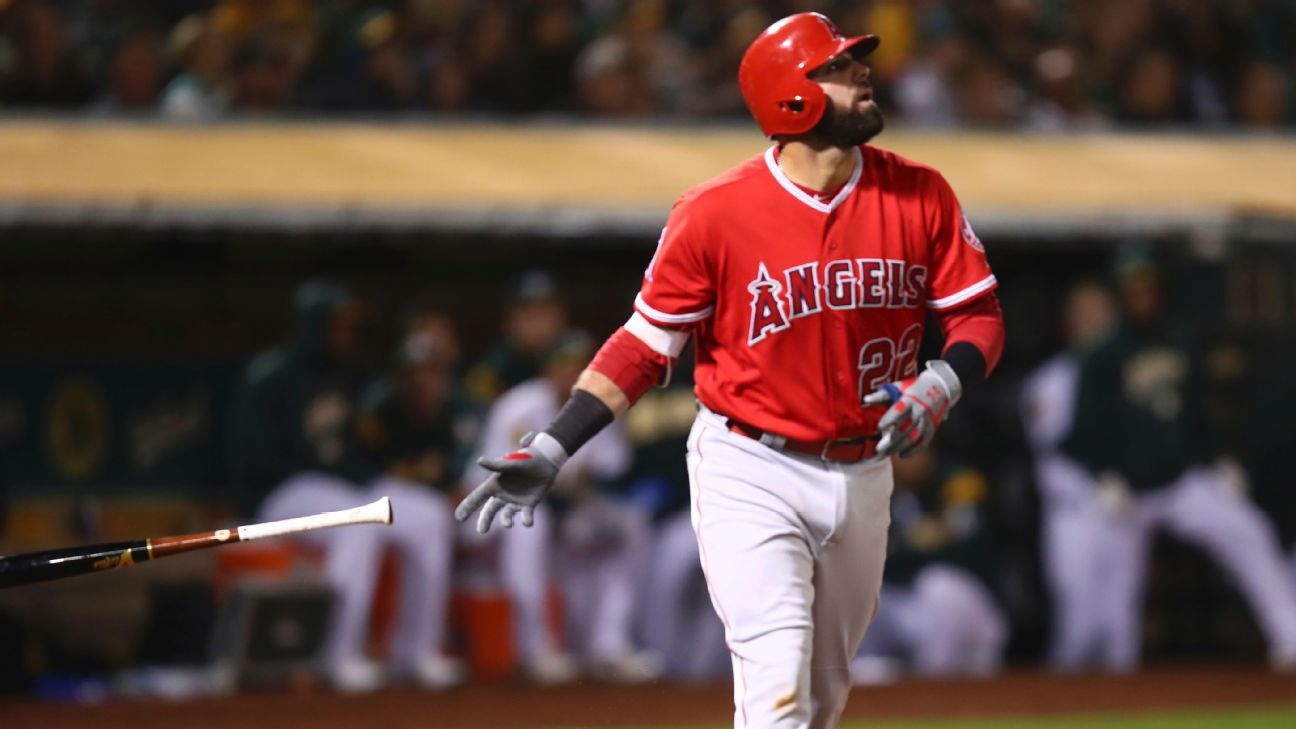LAS VEGAS — Shohei Ohtani might not be the game’s only two-way player for much longer.
On Monday, in the first day of the Winter Meetings from Las Vegas, the Seattle Mariners made an otherwise understated roster move that signified what might develop into a growing trend throughout the industry, claiming former first-round pick Kaleb Cowart off waivers from the Los Angeles Angels.
The Mariners said they will bring Cowart to spring training as a two-way player.
Cowart, who hasn’t pitched in the major leagues or at the minor league level, came up as a third baseman and has since developed into a utility player who can also handle second base, first base and left field. The Mariners, suddenly thrust into rebuilding mode, will add “right-handed pitcher” to Cowart’s job description, continuing an experiment that the Angels began earlier this offseason.
“I always enjoyed doing both,” Cowart said in a phone conversation. “I’m excited about it.”
Cowart, also a switch-hitter, was a highly-sought-after prospect coming out of Cook High School in South Georgia in 2010. He was named Gatorade Player of the Year as a senior, finishing with a 1.05 ERA and a .654 batting average. ESPN’s Keith Law called him “the top two-way prospect” in that year’s draft.
Roughly half the teams wanted him as a pitcher, but Cowart, ultimately the 18th overall selection by famed scouting director Eddie Bane, made it known that he would only forgo his Florida State scholarship to be a full-time position player.
“If somebody would’ve thrown something crazy at me, I probably would’ve pitched,” Cowart said. “But I really wanted to play [a position].”
It wasn’t until October, nine years removed from facing hitters, that Cowart got back on the mound.
The Angels spoke with Cowart and his agent towards the end of the 2018 season about the possibility of pitching. In the first week of the offseason, Cowart threw a bullpen session in front of Angels executives. He sat in the lower 90s with an arm that wasn’t fully in shape, and he said he mixed in a splitter, a cutter and a curveball.
Angels general manager Billy Eppler said he “thought it looked OK.” They presented two scenarios to Cowart — playing a few days a week and then pitching, or pitching exclusively — but decided to table a decision until Spring Training.
Cowart, however, was out of options. The Angels tendered him a contract, then tried to slip him through outright waivers in hopes of sending him to the minor leagues so he could keep working on pitching. That allowed the division-rival Mariners to claim him. Mariners GM Jerry Dipoto, who knows Cowart well from his time with the Angels, told reporters he thinks Cowart can be a successful two-way player who throws in the mid-90s.
“A pretty tough guy to compare to is Shohei Ohtani,” Cowart said when asked whether he could handle a two-way role. “But shoot, I mean, I can throw hard.”
Cowart struggled mightily in Double-A from 2013 to 2014, his OPS never getting as high as .620. He considered transitioning to a pitcher then, but held off once he found success hitting. This past season, while batting only .134/.210/.241 in 124 plate appearances, Cowart got an up-close look at Ohtani, who posted a .925 OPS and a 3.31 ERA to win the American League Rookie of the Year Award.
“It is really hard,” Cowart said of being a two-way player. “He has a huge workload. I mean, you have a huge workload if you’re just a hitter or just a pitcher. Imagine if you have to do both. Where the game is these days, the front office wants so much roster flexibility. And if you have a guy who can do this stuff, why not do it?”
The Tampa Bay Rays are attempting to groom the next two-way star in Brendan McKay, the fourth overall pick in last year’s draft. Tanner Dodson, one of the Rays’ second-round picks this year, is trying it out, too. Matt Davidson, non-tendered by the Chicago White Sox, might also be a fit in a two-way role.
Eppler has noticed players becoming more vocal about their ability to handle pitching and hitting.
“I do think that players are going to be more willing to do that because they’re going to look at it as another avenue to have versatility,” Eppler said from his room at the Mandalay Bay in Vegas. “It’s just another avenue for them, and so it makes sense that they would be open to it. And I think teams are just becoming more open-minded in general in baseball, with everything. ‘We’re going to play with four-man outfields,’ or, ‘We’re going to play with five-man infields.’ So, why not?”
